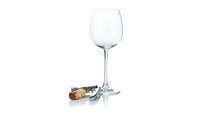Good glasses for gourmet guests
The right glass is more than a stylish statement by the restaurateur

Drinks play a central role in restaurants, bars and hotels around the globe. So a fine wine, beer or long drink glass is more than just a stylish statement by the restaurateur – it noticeably enhances the diner's experience. You see, a high-quality drink requires the right glass. It is principally the shape and size of the vessel which impact flavour and enjoyment. That is why you should always use a classic white wine glass when enjoying a good white wine. The aromas would immediately dissipate in a large bowl glass. Red wines, on the other hand, develop more slowly – they need air to breathe. A Burgundy or pinot noir is much more at home in a large, roomy glass with plenty of air contact, allowing the complex aromas to develop.

Drinks can be consumed from many different vessels - however, sophisticated wine tasting is only possible from a glass.
But shape and size are just one aspect. In order for the glass to really aid in the enjoyment of a drink, it must also be truly clean. Detergent residues or improper storage can produce a nasty aftertaste. For example, if glasses are stored upside down in boxes they quickly pick up a stale odour of cardboard. This kind of foreign odour can have a severe negative impact on the aromas in wine or other drinks.
Many factors come together to achieve perfect dishwashing results. That includes glass quality, which plays a prominent role since glasses in the food-service industry have to go through hundreds or even thousands of wash cycles and still look like new. Leading glass manufacturers have optimised their glass manufacturing methods to such an extent that even expensive glasses no longer need to be washed by hand – and the fact that they are dishwasher-proof means they tend to remain pristine for longer. Commercial dishwashing machine manufacturers have been working on the problem too, constantly developing their technologies further in order to achieve the best dishwashing results. One goal is to avoid what is known as glass corrosion. This is when chemical processes attack the basic structure of the material until the glass becomes unsightly and unusable over time.
1,000 washes in and as good as new
Restaurateurs and hoteliers should view glassware as part of the value chain and include it in their calculations. ‘A high-quality glass can be washed around 1,000 times,’ says Klaus Völkner, Head of Sales for Germany at renowned German glass manufacturer Stölzle in the Saxon part of Lusatia, a region shared between Germany and Poland. But he also knows that, ‘That same glass will only make it through the dishwasher a maximum of 400 times’ – then, in most cases, it will end up in pieces being swept off the floor. Another mistake is to leave glasses in the machine for too long, exposing them to the risk of glass corrosion.
The quality of the material is just one of the properties that can encourage such processes. Other decisive factors include water quality, wash cycle time, water temperature, detergent and rinse aid, not to mention, most importantly, how the dishwashing machine is operated and how it works. It has been proven, though, that glass corrosion is primarily related to the quality of the glass. This was also confirmed by a study conducted by the Fraunhofer Institute for Silicate Research in Würzburg, Germany. The researchers discovered that window glass dating from the 11th to the 16th centuries has a low chemical resistance to environmental factors due to its high content of potassium and calcium oxide (source: Wikipedia, Glass corrosion).
Glass corrosion
Unfavourable chemical and physical phenomena can cause the surface of glasses to become ‘weathered’, a process referred to in the industry as glass corrosion. It is also known as glass disease, sick glass or glass illness. Close inspection reveals a microscopically thin roughening of the surface. In chemical terms this is due to the leaching of oxides such as sodium, potassium, calcium, barium and boron. The areas of glass affected by this process experience a change in their physical properties. This impairs the surface transparency and leads to microscopically fine cracking, also called crizzling.
Clinking and rattling causes damage
If washware is packed together too tightly in the dishwashing machine rack, they only need to briefly touch other glasses to cause a roughening of the surface and unsightly marks at the point of contact. Glasses should therefore never touch at the widest point of the glass bulge. The way to protect against chatter damage is to load the rack with plenty of ‘air’ gaps.
Experts also agree that professional glassware management can make a meaningful and noticeable difference to a company's value creation strategy. Lastly, fine glassware contributes to a pleasant tone in the restaurant and tops off the fine dining experience. There is a reason why top-class, Michelin-starred restaurants tend to prefer hand-blown glasses. They complete the high-quality ambience of a restaurant in terms of optics.
Cloudy or foggy glass
There are some glasses that can even be corroded by excessively hot water. This typically appears as fuzzy or cloudy patches on the glass. This type of corrosion can be traced back to the material or manufacturing process.


